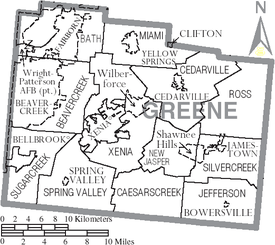

BLOG – The history of Greene County is still interesting
- Published: April 2, 2016
Last week this blog reported on some of the early history of Miami Township, and the books I referenced read with such an enjoyable and endearingly old-school tone that I had to dive in for more. Below are some more odds and ends from the annals of the area’s history, thanks to the work of our historians of yore and the staff of your local library! A stamp on of the books says “The public library is yours – use it.” I couldn’t agree more!
Michael A. Broadstone reports in History of Greene County, Ohio that Greene County’s first Women’s Christian Temperance Union was formed in 1874, and may have been one of the first in the US. The WCTU was one of the groups most ardently pushing for reform that ultimately resulted in the passage of the 18th Amendment, or Prohibition. It appears their movement got off to a good start in Greene County, as February 1874 “witnessed the beginning of a spectacular temperance crusade, the like of which had never before been seen,” as the group reportedly closed down thirteen Xenia saloons in the course of three weeks.
“Seven bands of 25 to 40 women” gathered on the sidewalks in front of the saloons and embarked on a campaign of prayer, singing, and speechifying about the perils of alcohol. One of the first saloons they picketed was a place called “Shades of Death.” The women worked in shifts and were able to warm up in the shop of a “friendly blacksmith” down the street. Supposedly not long after they started, the owner of the Shades of Death came out and said he was ready to change his ways. He invited the women to pour out his alcohol in the street, an invitation that was “eagerly accepted.” However, the WTCU was not just interested in putting saloons out of business but in helping erstwhile saloonkeepers pursue a new career. The women raised enough money to open a meat market for the former owner of the Shades of Death, and he began running a butcher shop called the “Dawn of Day.”
“There are some things which cannot be measured with the foot rule or gauged by the scale, and one of these things the work of the women who have fought so nobly for temperance,” Broadstone says.
Some people, however, cannot be reformed so easily and were made to pay the ultimate price. The first execution in Greene County took place on January 25, 1850. Jesse Ransbottom of Fairfield was hanged for killing his wife out of jealously. Attempts to take his own life after the murder were unsuccessful – he left only a few scratches on his throat because “it hurt too bad” – and so he was doomed to die after 25 witnesses testified against him. A scaffold was erected on Greene Street in Xenia, surrounded by a fence 18 feet high. When asked if he had any last words of requests, Ransbottom gazed off into the distance and asked that he be buried in Champaign County. The sheriff, “flustered” after already having dug a grave just outside of Xenia, sidestepped the request and said he would make sure he was buried with dignity. The local paper said Ransbottom died “without a struggle.”
On a more positive and literally musical note, the first piano in Ohio, and “certainly the first west of the Alleghenies,” was made by a resident of Greene County. A guy named George Charters apprenticed with a firm in New York to learn the “art and mystery of the manufacture of musical instruments,” and at the end of his apprenticeship went into business making piano fortes. He moved from New York to Cincinnati with his family, and then to Greene County in 1833, settling near Bellbrook because no Presbyterian community existed in Cincinnati. He started a new piano-making business but there isn’t any way to tell how many pianos he might have made, as his new community had “so many people with religious objections to the use of piano that he could not find a sale for all of them.” Nevertheless, his son John went into the piano business after him, later installing himself as the town’s premier daguerreotype artists thanks to his skills in chemistry, as the town’s initial daguerrotypist was “so deficient” in chemistry that he often needed Chambers’ help.
And lastly for this installment, no less a historical titan than Abraham Lincoln himself set foot in Greene County on Wednesday, February 13, 1861, on his way from Springfield, Illinois to Washington DC to be sworn in as President. As soon as Lincoln stepped onto the platform at 11:55 a.m. a cannon boomed from a nearby hill. As Broadstone records, Lincoln “spoke for a few minutes and shook hands with a number of citizens fortunate enough to be near the train.”

The Yellow Springs News encourages respectful discussion of this article.
You must login to post a comment.
Don't have a login? Register for a free YSNews.com account.













No comments yet for this article.